Nature & Science Omnibus Thread
Previous 1 ... 43 44 45 46 47 48 49 ... 72 Next
DrCaleb @ Thu Aug 19, 2021 8:11 am
$1:
Canadian Nobel scientist's deletion from Wikipedia points to wider bias, study finds
. . .
The case of the Canadian Nobel prizewinner
A well-known example is what happened to Canadian scientist Donna Strickland, who couldn't be found on Wikipedia immediately after she won the Nobel Prize in Physics in 2018.
"People started realizing, 'Oh my goodness, here is this extremely remarkable Nobel Prize winner who doesn't have a Wikipedia page. How is that possible?'" Tripodi recalled.
"But then [they] realized, 'Oh dear, it's even worse than we thought.' Because she did have a Wikipedia page. But it was nominated for deletion and then deleted."
There is some contention over why Strickland's page was deleted.
Why it happens
Some critics say it was gender bias, while others say it was a problem with notability, a gauge editors use to determine if a topic deserves a Wiki page. Wikipedia editors must be able to verify facts about any Wiki entry against published reliable sources, from publications to the press.
Interpretations of what is notable lead to gender inequality on the platform, said Tripodi, who is an assistant professor and a senior researcher at the Centre for Information Technology and Public Life at University of North Carolina at Chapel Hill.
"So there's already this first layer of difficulty when it comes to adding women, because there's just less material out there in the world that is required in order to establish notability on Wikipedia," she said.
. . .
The case of the Canadian Nobel prizewinner
A well-known example is what happened to Canadian scientist Donna Strickland, who couldn't be found on Wikipedia immediately after she won the Nobel Prize in Physics in 2018.
"People started realizing, 'Oh my goodness, here is this extremely remarkable Nobel Prize winner who doesn't have a Wikipedia page. How is that possible?'" Tripodi recalled.
"But then [they] realized, 'Oh dear, it's even worse than we thought.' Because she did have a Wikipedia page. But it was nominated for deletion and then deleted."
There is some contention over why Strickland's page was deleted.
Why it happens
Some critics say it was gender bias, while others say it was a problem with notability, a gauge editors use to determine if a topic deserves a Wiki page. Wikipedia editors must be able to verify facts about any Wiki entry against published reliable sources, from publications to the press.
Interpretations of what is notable lead to gender inequality on the platform, said Tripodi, who is an assistant professor and a senior researcher at the Centre for Information Technology and Public Life at University of North Carolina at Chapel Hill.
"So there's already this first layer of difficulty when it comes to adding women, because there's just less material out there in the world that is required in order to establish notability on Wikipedia," she said.
https://www.cbc.ca/news/science/wikiped ... -1.6129073
Scape @ Thu Aug 19, 2021 1:43 pm
The help tab on her page is a good read:
https://en.wikipedia.org/wiki/Talk:Donna_Strickland
DrCaleb @ Mon Aug 23, 2021 6:35 am
If I have a philosophy of life, LaPlace and Bayes are big parts of it.
DrCaleb @ Mon Aug 23, 2021 8:34 am
Richard Feynman was an amazing educator. This lesson should be emphasized for anyone who doubts Science.
DrCaleb @ Thu Sep 02, 2021 9:36 am
$1:
Researchers develop bionic arm that restores natural behaviors in patients with upper limb amputations
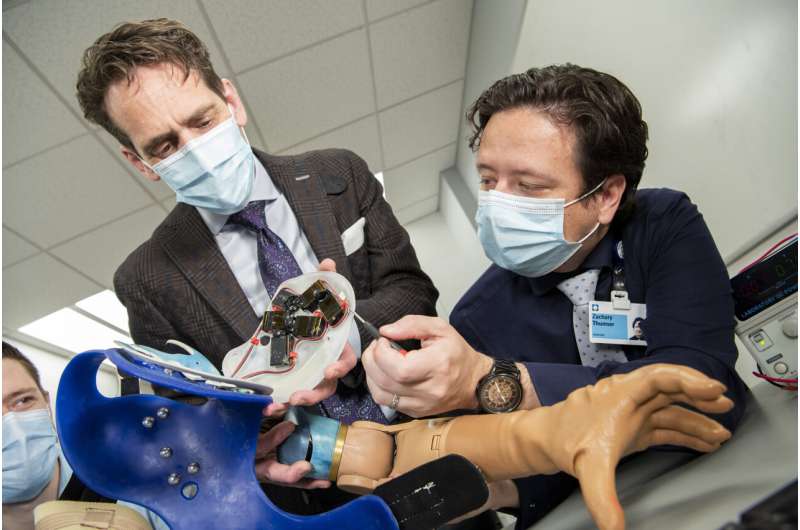
Cleveland Clinic researchers have engineered a first-of-its-kind bionic arm for patients with upper-limb amputations that allows wearers to think, behave and function like a person without an amputation, according to new findings published in Science Robotics.
The Cleveland Clinic-led international research team developed the bionic system that combines three important functions—intuitive motor control, touch and grip kinesthesia, the intuitive feeling of opening and closing the hand. Collaborators included University of Alberta and University of New Brunswick.
"We modified a standard-of-care prosthetic with this complex bionic system which enables wearers to move their prosthetic arm more intuitively and feel sensations of touch and movement at the same time," said lead investigator Paul Marasco, Ph.D., associate professor in Cleveland Clinic Lerner Research Institute's Department of Biomedical Engineering. "These findings are an important step towards providing people with amputation with complete restoration of natural arm function."
The system is the first to test all three sensory and motor functions in a neural-machine interface all at once in a prosthetic arm. The neural-machine interface connects with the wearer's limb nerves. It enables patients to send nerve impulses from their brains to the prosthetic when they want to use or move it, and to receive physical information from the environment and relay it back to their brain through their nerves.

Cleveland Clinic researchers have engineered a first-of-its-kind bionic arm for patients with upper-limb amputations that allows wearers to think, behave and function like a person without an amputation, according to new findings published in Science Robotics.
The Cleveland Clinic-led international research team developed the bionic system that combines three important functions—intuitive motor control, touch and grip kinesthesia, the intuitive feeling of opening and closing the hand. Collaborators included University of Alberta and University of New Brunswick.
"We modified a standard-of-care prosthetic with this complex bionic system which enables wearers to move their prosthetic arm more intuitively and feel sensations of touch and movement at the same time," said lead investigator Paul Marasco, Ph.D., associate professor in Cleveland Clinic Lerner Research Institute's Department of Biomedical Engineering. "These findings are an important step towards providing people with amputation with complete restoration of natural arm function."
The system is the first to test all three sensory and motor functions in a neural-machine interface all at once in a prosthetic arm. The neural-machine interface connects with the wearer's limb nerves. It enables patients to send nerve impulses from their brains to the prosthetic when they want to use or move it, and to receive physical information from the environment and relay it back to their brain through their nerves.
https://techxplore.com/news/2021-09-bio ... ients.html
DrCaleb @ Tue Sep 07, 2021 7:13 am
$1:
This Australian duck says ‘You bloody fool’ and can imitate other sounds — and scientists couldn’t be more fascinated
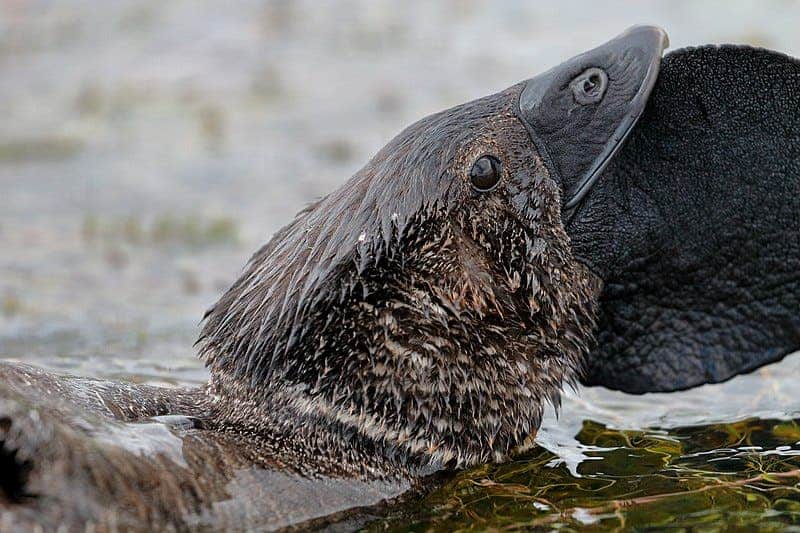
When biologist Carel ten Cate heard rumors of a talking duck in Australia, he brushed it off like a comical anecdote, like any sane human being. But his curiosity got the better of him, so he tracked down a well-respected Australian scientist who first noticed this phenomenon more than three decades ago. After listening to verified footage showing an adult musk duck vocalizing the sounds of a door slamming or squeaking, a pony snorting, a man coughing, and even the all too familiar slur “You bloody fool!”, the Dutch biologist was simply stunned. Listen for yourself

When biologist Carel ten Cate heard rumors of a talking duck in Australia, he brushed it off like a comical anecdote, like any sane human being. But his curiosity got the better of him, so he tracked down a well-respected Australian scientist who first noticed this phenomenon more than three decades ago. After listening to verified footage showing an adult musk duck vocalizing the sounds of a door slamming or squeaking, a pony snorting, a man coughing, and even the all too familiar slur “You bloody fool!”, the Dutch biologist was simply stunned. Listen for yourself
https://www.zmescience.com/ecology/anim ... ascinated/
DrCaleb @ Wed Sep 08, 2021 6:33 am
$1:
Massive new animal species discovered in half-billion-year-old Burgess Shale
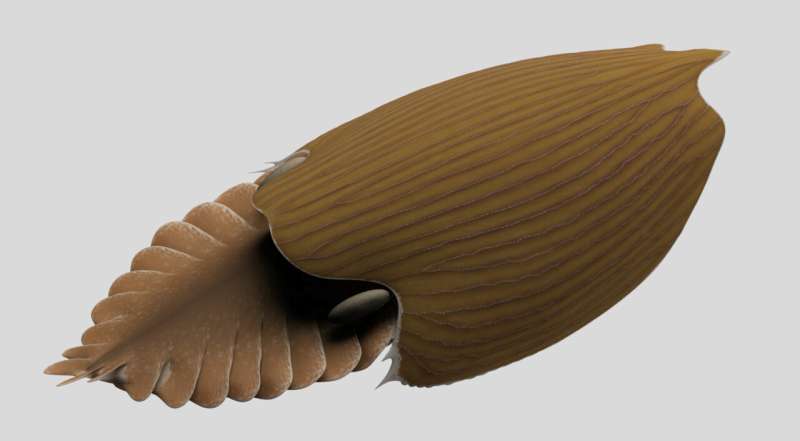
Palaeontologists at the Royal Ontario Museum (ROM) have uncovered the remains of a huge new fossil species belonging to an extinct animal group in half-a-billion-year-old Cambrian rocks from Kootenay National Park in the Canadian Rockies. The findings were announced on September 8, 2021, in a study published in Royal Society Open Science.
Named Titanokorys gainesi, this new species is remarkable for its size. With an estimated total length of half a meter, Titanokorys was a giant compared to most animals that lived in the seas at that time, most of which barely reached the size of a pinky finger.
"The sheer size of this animal is absolutely mind-boggling, this is one of the biggest animals from the Cambrian period ever found," says Jean-Bernard Caron, ROM's Richard M. Ivey Curator of Invertebrate Palaeontology.
Evolutionarily speaking, Titanokorys belongs to a group of primitive arthropods called radiodonts. The most iconic representative of this group is the streamlined predator Anomalocaris, which may itself have approached a meter in length. Like all radiodonts, Titanokorys had multifaceted eyes, a pineapple slice-shaped, tooth-lined mouth, a pair of spiny claws below its head to capture prey and a body with a series of flaps for swimming. Within this group, some species also possessed large, conspicuous head carapaces, with Titanokorys being one of the largest ever known.
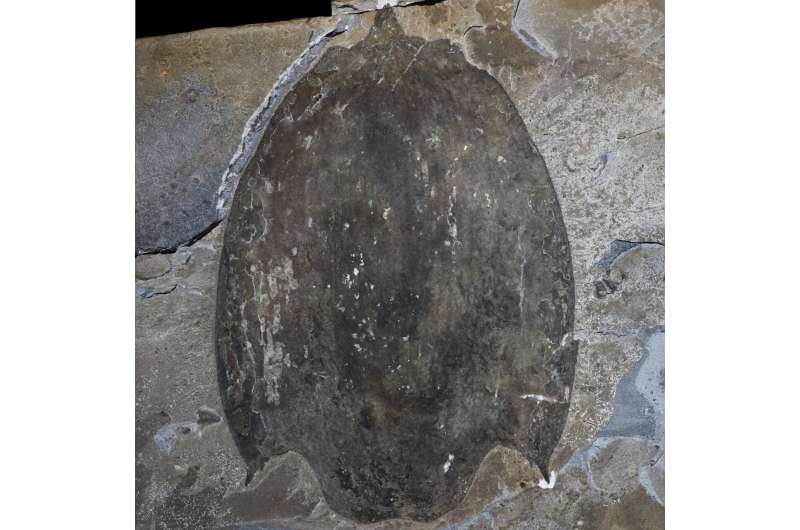

Palaeontologists at the Royal Ontario Museum (ROM) have uncovered the remains of a huge new fossil species belonging to an extinct animal group in half-a-billion-year-old Cambrian rocks from Kootenay National Park in the Canadian Rockies. The findings were announced on September 8, 2021, in a study published in Royal Society Open Science.
Named Titanokorys gainesi, this new species is remarkable for its size. With an estimated total length of half a meter, Titanokorys was a giant compared to most animals that lived in the seas at that time, most of which barely reached the size of a pinky finger.
"The sheer size of this animal is absolutely mind-boggling, this is one of the biggest animals from the Cambrian period ever found," says Jean-Bernard Caron, ROM's Richard M. Ivey Curator of Invertebrate Palaeontology.
Evolutionarily speaking, Titanokorys belongs to a group of primitive arthropods called radiodonts. The most iconic representative of this group is the streamlined predator Anomalocaris, which may itself have approached a meter in length. Like all radiodonts, Titanokorys had multifaceted eyes, a pineapple slice-shaped, tooth-lined mouth, a pair of spiny claws below its head to capture prey and a body with a series of flaps for swimming. Within this group, some species also possessed large, conspicuous head carapaces, with Titanokorys being one of the largest ever known.

https://phys.org/news/2021-09-massive-a ... rgess.html
DrCaleb @ Fri Sep 10, 2021 6:18 am
$1:
Groundbreaking Technique Yields Important New Details on Silicon, Subatomic Particles and Possible ‘Fifth Force’
Using a groundbreaking new technique at the National Institute of Standards and Technology (NIST), an international collaboration led by NIST researchers has revealed previously unrecognized properties of technologically crucial silicon crystals and uncovered new information about an important subatomic particle and a long-theorized fifth force of nature.
By aiming subatomic particles known as neutrons at silicon crystals and monitoring the outcome with exquisite sensitivity, the NIST scientists were able to obtain three extraordinary results: the first measurement of a key neutron property in 20 years using a unique method; the highest-precision measurements of the effects of heat-related vibrations in a silicon crystal; and limits on the strength of a possible “fifth force” beyond standard physics theories.
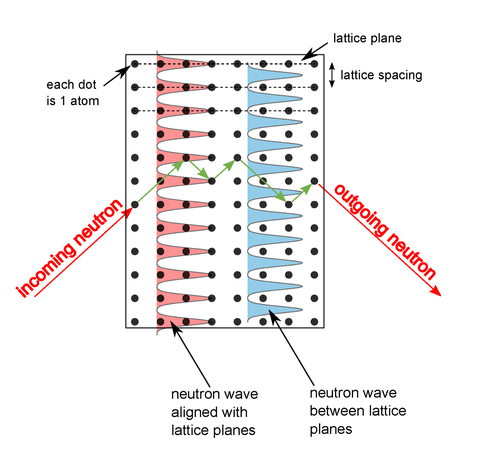
As neutrons pass through a crystal, they create two different standing waves – one along atomic planes and one between them. The interaction of these waves affects the path of the neutron, revealing aspects of the crystal structure.
Credit: NIST
The researchers report their findings in the journal Science.
To obtain information about crystalline materials at the atomic scale, scientists typically aim a beam of particles (such as X-rays, electrons or neutrons) at the crystal and detect the beam’s angles, intensities and patterns as it passes through or ricochets off planes in the crystal’s lattice-like atomic geometry.
That information is critically important for characterizing the electronic, mechanical and magnetic properties of microchip components and various novel nanomaterials for next-generation applications including quantum computing. A great deal is known already, but continued progress requires increasingly detailed knowledge.
“A vastly improved understanding of the crystal structure of silicon, the ‘universal’ substrate or foundation material on which everything is built, will be crucial in understanding the nature of components operating near the point at which the accuracy of measurements is limited by quantum effects,” said NIST senior project scientist Michael Huber.

Using a groundbreaking new technique at the National Institute of Standards and Technology (NIST), an international collaboration led by NIST researchers has revealed previously unrecognized properties of technologically crucial silicon crystals and uncovered new information about an important subatomic particle and a long-theorized fifth force of nature.
By aiming subatomic particles known as neutrons at silicon crystals and monitoring the outcome with exquisite sensitivity, the NIST scientists were able to obtain three extraordinary results: the first measurement of a key neutron property in 20 years using a unique method; the highest-precision measurements of the effects of heat-related vibrations in a silicon crystal; and limits on the strength of a possible “fifth force” beyond standard physics theories.

$1:
As neutrons pass through a crystal, they create two different standing waves – one along atomic planes and one between them. The interaction of these waves affects the path of the neutron, revealing aspects of the crystal structure.
Credit: NIST
The researchers report their findings in the journal Science.
To obtain information about crystalline materials at the atomic scale, scientists typically aim a beam of particles (such as X-rays, electrons or neutrons) at the crystal and detect the beam’s angles, intensities and patterns as it passes through or ricochets off planes in the crystal’s lattice-like atomic geometry.
That information is critically important for characterizing the electronic, mechanical and magnetic properties of microchip components and various novel nanomaterials for next-generation applications including quantum computing. A great deal is known already, but continued progress requires increasingly detailed knowledge.
“A vastly improved understanding of the crystal structure of silicon, the ‘universal’ substrate or foundation material on which everything is built, will be crucial in understanding the nature of components operating near the point at which the accuracy of measurements is limited by quantum effects,” said NIST senior project scientist Michael Huber.

$1:
In a regular crystal such as silicon, there are many parallel sheets of atoms, each of which forms a plane. Probing different planes with neutrons reveals different aspects of the crystal.
Credit: NIST
Credit: NIST
https://www.nist.gov/news-events/news/2 ... -subatomic
DrCaleb @ Wed Sep 15, 2021 7:43 am
$1:
Simple Mathematical Law Predicts Movement in Cities around the World
A new model could help model disease transmission and urban planning
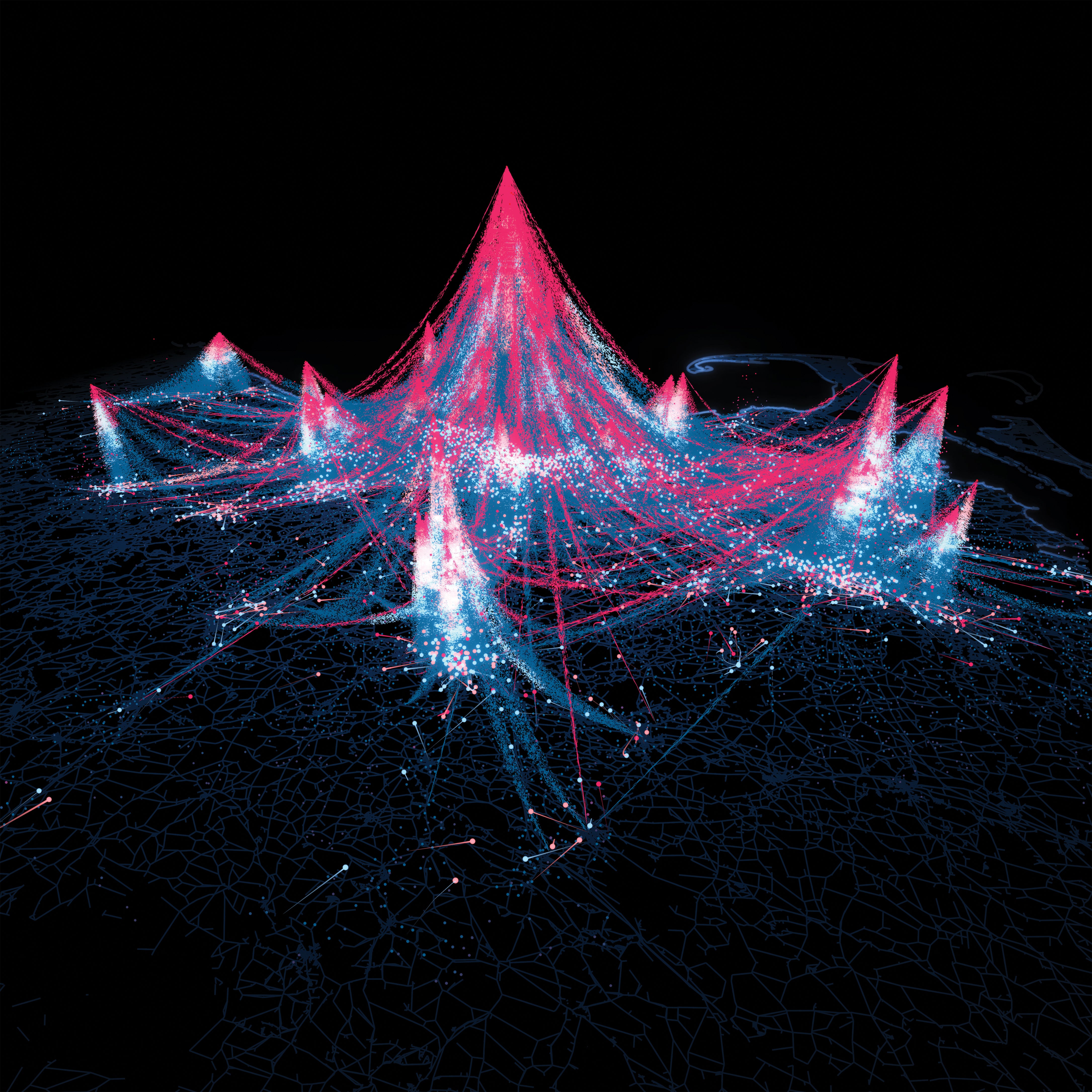
The people who happen to be in a city center at any given moment may seem like a random collection of individuals. But new research featuring a simple mathematical law shows that urban travel patterns worldwide are, in fact, remarkably predictable regardless of location—an insight that could enhance models of disease spread and help to optimize city planning.
Studying anonymized cell-phone data, researchers discovered what is known as an inverse square relation between the number of people in a given urban location and the distance they traveled to get there, as well as how frequently they made the trip. It may seem intuitive that people visit nearby locations frequently and distant ones less so, but the newly discovered relation puts the concept into specific numerical terms. It accurately predicts, for instance, that the number of people coming from two kilometers away five times per week will be the same as the number coming from five kilometers twice a week. The researchers' new visitation law, and a versatile model of individuals' movements within cities based on it, was reported in Nature.
“This is a super striking, robust result,” says Laura Alessandretti, a computational social scientist at the Technical University of Denmark, who was not involved in the study but co-wrote an accompanying commentary. “We tend to think that there are lots of contextual aspects that affect the way we move, such as the transportation system, the morphology of a given place, and socioeconomic aspects. This is true to some extent, but what this shows is that there are some robust laws that apply everywhere.”
A new model could help model disease transmission and urban planning

$1:
Visualization depicts visitor flows across the greater Boston area from cell-phone data. Thickness indicates number of visitors, and color indicates visit frequency. Credit: MIT Senseable City Laboratory
The people who happen to be in a city center at any given moment may seem like a random collection of individuals. But new research featuring a simple mathematical law shows that urban travel patterns worldwide are, in fact, remarkably predictable regardless of location—an insight that could enhance models of disease spread and help to optimize city planning.
Studying anonymized cell-phone data, researchers discovered what is known as an inverse square relation between the number of people in a given urban location and the distance they traveled to get there, as well as how frequently they made the trip. It may seem intuitive that people visit nearby locations frequently and distant ones less so, but the newly discovered relation puts the concept into specific numerical terms. It accurately predicts, for instance, that the number of people coming from two kilometers away five times per week will be the same as the number coming from five kilometers twice a week. The researchers' new visitation law, and a versatile model of individuals' movements within cities based on it, was reported in Nature.
“This is a super striking, robust result,” says Laura Alessandretti, a computational social scientist at the Technical University of Denmark, who was not involved in the study but co-wrote an accompanying commentary. “We tend to think that there are lots of contextual aspects that affect the way we move, such as the transportation system, the morphology of a given place, and socioeconomic aspects. This is true to some extent, but what this shows is that there are some robust laws that apply everywhere.”
https://www.scientificamerican.com/arti ... he-world/#
raydan @ Sat Sep 18, 2021 1:54 pm
The Tug of War that Shapes the Universe
$1:
As the universe expanded from the Big Bang, regions where the density of matter was higher than average grew into galaxies and clusters of galaxies. The overall form of the universe and the evolution of galaxies within it have been shaped by a delicate balance of two competing forces – the inward gravitational pull of matter, dominated by dark matter, and the outward stretching of space, controlled by a mysterious force called dark energy. In this lecture, I will describe how we can gain an understanding of these hidden elements by measuring the properties of galaxies and the web of structure they form. The Dark Energy Survey (DES) has done this for one-eighth of the sky, observing and measuring more than 100 million galaxies. I will illustrate how we use DES images of this huge number of galaxies to trace the growth of structure and measure the expansion of the universe under the influence of its dark components.
Justin Myles
Thursday, September 30, 2021 5:00 pm
Join us on Zoom (passcode 650650)
https://www6.slac.stanford.edu/public-lectures
CDN_PATRIOT @ Sun Sep 19, 2021 7:13 am
DrCaleb DrCaleb:
$1:
Massive new animal species discovered in half-billion-year-old Burgess Shale

Palaeontologists at the Royal Ontario Museum (ROM) have uncovered the remains of a huge new fossil species belonging to an extinct animal group in half-a-billion-year-old Cambrian rocks from Kootenay National Park in the Canadian Rockies. The findings were announced on September 8, 2021, in a study published in Royal Society Open Science.
Named Titanokorys gainesi, this new species is remarkable for its size. With an estimated total length of half a meter, Titanokorys was a giant compared to most animals that lived in the seas at that time, most of which barely reached the size of a pinky finger.
"The sheer size of this animal is absolutely mind-boggling, this is one of the biggest animals from the Cambrian period ever found," says Jean-Bernard Caron, ROM's Richard M. Ivey Curator of Invertebrate Palaeontology.
Evolutionarily speaking, Titanokorys belongs to a group of primitive arthropods called radiodonts. The most iconic representative of this group is the streamlined predator Anomalocaris, which may itself have approached a meter in length. Like all radiodonts, Titanokorys had multifaceted eyes, a pineapple slice-shaped, tooth-lined mouth, a pair of spiny claws below its head to capture prey and a body with a series of flaps for swimming. Within this group, some species also possessed large, conspicuous head carapaces, with Titanokorys being one of the largest ever known.


Palaeontologists at the Royal Ontario Museum (ROM) have uncovered the remains of a huge new fossil species belonging to an extinct animal group in half-a-billion-year-old Cambrian rocks from Kootenay National Park in the Canadian Rockies. The findings were announced on September 8, 2021, in a study published in Royal Society Open Science.
Named Titanokorys gainesi, this new species is remarkable for its size. With an estimated total length of half a meter, Titanokorys was a giant compared to most animals that lived in the seas at that time, most of which barely reached the size of a pinky finger.
"The sheer size of this animal is absolutely mind-boggling, this is one of the biggest animals from the Cambrian period ever found," says Jean-Bernard Caron, ROM's Richard M. Ivey Curator of Invertebrate Palaeontology.
Evolutionarily speaking, Titanokorys belongs to a group of primitive arthropods called radiodonts. The most iconic representative of this group is the streamlined predator Anomalocaris, which may itself have approached a meter in length. Like all radiodonts, Titanokorys had multifaceted eyes, a pineapple slice-shaped, tooth-lined mouth, a pair of spiny claws below its head to capture prey and a body with a series of flaps for swimming. Within this group, some species also possessed large, conspicuous head carapaces, with Titanokorys being one of the largest ever known.

https://phys.org/news/2021-09-massive-a ... rgess.html
This is actually pretty cool. Being somewhat of a fossil nut from time to time, I find it very fascinating whenever a new species is unearthed like this. I had a VIP membership at the R.O.M. for several years, and it was always awesome to see new things, and be part of the discussion in regards to finds like these.
The R.O.M. has always been one of my favourite places, and their people are top notch.
-J.
DrCaleb @ Wed Sep 22, 2021 7:11 am
Lethal microbial blooms delayed freshwater ecosystem recovery following the end-Permian extinction
$1:
A Warning Sign of a Mass Extinction Event Is on the Rise, Scientists Say
Toxic microbial blooms thrived during the Great Dying, the most severe extinction in Earth's history, and they are proliferating again due to human activity.
If you live near a freshwater river or lake, odds are good that you have seen warning signs about harmful algal and bacterial blooms posted on its shores. Alarmingly, a new study reports that these blooms may be early indicators of an ongoing ecological disaster, caused by humans, that eerily parallels the worst extinction event in Earth’s history.
Some 251 million years ago, the end-Permian event (EPE), popularly known as the “Great Dying,” wiped out nearly 90 percent of species on Earth, making it the most severe loss of life in our planet’s history.
Ominous parallels of that upheaval are now showing up on Earth, according to a team led by Chris Mays, a postdoctoral researcher and palaeobotanist at the Swedish Museum of Natural History in Stockholm. The researchers found that toxic algal and bacterial blooms during the Great Dying are similar to a recent microbial proliferation in modern lakes and rivers—a trend that has been linked to human activities such as greenhouse gas emissions (especially carbon dioxide), deforestation, and soil loss.
“We are not there yet,” Mays said in an email, referring to the conditions of the EPE. “There was probably a six-fold increase in carbon dioxide during the EPE, but today carbon dioxide levels haven't yet doubled since pre-industrial times.”
Toxic microbial blooms thrived during the Great Dying, the most severe extinction in Earth's history, and they are proliferating again due to human activity.
If you live near a freshwater river or lake, odds are good that you have seen warning signs about harmful algal and bacterial blooms posted on its shores. Alarmingly, a new study reports that these blooms may be early indicators of an ongoing ecological disaster, caused by humans, that eerily parallels the worst extinction event in Earth’s history.
Some 251 million years ago, the end-Permian event (EPE), popularly known as the “Great Dying,” wiped out nearly 90 percent of species on Earth, making it the most severe loss of life in our planet’s history.
Ominous parallels of that upheaval are now showing up on Earth, according to a team led by Chris Mays, a postdoctoral researcher and palaeobotanist at the Swedish Museum of Natural History in Stockholm. The researchers found that toxic algal and bacterial blooms during the Great Dying are similar to a recent microbial proliferation in modern lakes and rivers—a trend that has been linked to human activities such as greenhouse gas emissions (especially carbon dioxide), deforestation, and soil loss.
“We are not there yet,” Mays said in an email, referring to the conditions of the EPE. “There was probably a six-fold increase in carbon dioxide during the EPE, but today carbon dioxide levels haven't yet doubled since pre-industrial times.”
https://www.vice.com/en/article/bvzqg5/ ... ntists-say
DrCaleb @ Thu Sep 23, 2021 12:13 pm
$1:
Infants have more microplastics in their feces than adults, study finds
Microplastics—tiny plastic pieces less than 5 mm in size—are everywhere, from indoor dust to food to bottled water. So it's not surprising that scientists have detected these particles in the feces of people and pets. Now, in a small pilot study, researchers reporting in ACS' Environmental Science & Technology Letters discovered that infants have higher amounts of one type of microplastic in their stool than adults. Health effects, if any, are uncertain.
Little is known about the magnitude of human exposure to microplastics or their health effects. Although microplastics were once thought to pass harmlessly through the gastrointestinal tract and exit the body, recent studies suggest that the tiniest pieces can cross cell membranes and enter the circulation. In cells and laboratory animals, microplastic exposure can cause cell death, inflammation and metabolic disorders. Kurunthachalam Kannan at the New York University School of Medicine and colleagues wanted to assess human exposure to two common microplastics—polyethylene terephthalate (PET) and polycarbonate (PC)—by measuring levels in infant and adult feces.
The researchers used mass spectrometry to determine the concentrations of PET and PC microplastics in six infant and 10 adult feces samples collected from New York state, as well as in three samples of meconium (a newborn infant's first stool). All samples contained at least one type of microplastic. Although average levels of fecal PC microplastics were similar between adults and infants, infant stool contained, on average, more than 10 times higher PET concentrations than that of adults.
Infants could be exposed to higher levels of microplastics through their extensive use of products such as bottles, teethers and toys, the researchers say. However, they note that larger studies are needed to corroborate these findings.
Microplastics—tiny plastic pieces less than 5 mm in size—are everywhere, from indoor dust to food to bottled water. So it's not surprising that scientists have detected these particles in the feces of people and pets. Now, in a small pilot study, researchers reporting in ACS' Environmental Science & Technology Letters discovered that infants have higher amounts of one type of microplastic in their stool than adults. Health effects, if any, are uncertain.
Little is known about the magnitude of human exposure to microplastics or their health effects. Although microplastics were once thought to pass harmlessly through the gastrointestinal tract and exit the body, recent studies suggest that the tiniest pieces can cross cell membranes and enter the circulation. In cells and laboratory animals, microplastic exposure can cause cell death, inflammation and metabolic disorders. Kurunthachalam Kannan at the New York University School of Medicine and colleagues wanted to assess human exposure to two common microplastics—polyethylene terephthalate (PET) and polycarbonate (PC)—by measuring levels in infant and adult feces.
The researchers used mass spectrometry to determine the concentrations of PET and PC microplastics in six infant and 10 adult feces samples collected from New York state, as well as in three samples of meconium (a newborn infant's first stool). All samples contained at least one type of microplastic. Although average levels of fecal PC microplastics were similar between adults and infants, infant stool contained, on average, more than 10 times higher PET concentrations than that of adults.
Infants could be exposed to higher levels of microplastics through their extensive use of products such as bottles, teethers and toys, the researchers say. However, they note that larger studies are needed to corroborate these findings.
https://phys.org/news/2021-09-infants-m ... dults.html
DrCaleb @ Fri Sep 24, 2021 6:06 am
$1:
23,000-year-old footprints suggest people reached the Americas early

Footprints left behind in layers of clay and silt at New Mexico’s White Sands National Park may be between 23,000 and 21,000 years old. That’s based on radiocarbon dating of the remains of grass seeds buried in the layers of sediment above and below the tracks. If the dates are correct, the tracks are evidence that people walked beside the now-dry Lake Otero during the height of the last ice age, when kilometers of ice covered the northern half of the continent. And that would mean that people must have arrived in North America—and made their way to an area well south of the ice—before the ice sheets expanded enough to close off the route.
Arriving ahead of the ice sheets
Bournemouth University archaeologist Matthew Bennett and his colleagues found a total of 61 human footprints east of an area called Alkali Flat, which was once the bed and shoreline of an ancient lake. Over time, as the lake’s edge expanded and contracted with shifts in climate, it left behind distinct layers of clay, silt, and sand. Seven of those layers, in the area Bennett and his colleagues recently excavated, held human tracks along with those of long-lost megafauna.
Some of the sediment layers contained the remains of ancient grass seeds mixed with the sediment. Bennett and his colleagues radiocarbon-dated seeds from the layer just below the oldest footprints and the layer just above the most recent ones. According to the results, the oldest footprints were made sometime after 23,000 years ago; the most recent ones were made sometime before 21,000 years ago. At that time, the northern half of the continent was several kilometers below massive sheets of ice.
The ice sheets had completely blanketed most of Canada and the northernmost US around 26,000 years ago, and they wouldn’t begin to thaw and recede until around 20,000 years ago.
“These data provide definitive evidence of human occupation of North America south of the Laurentide ice sheet during the Last Glacial Maximum,” wrote Bennett and his colleagues in their recent paper. And anyone who lived in what’s now New Mexico during this period, known as the Last Glacial Maximum, must have arrived before the ice sheets closed off the route from Asia into the Americas.
If that’s the case, we may have to rethink our species’ role in the extinction of megafauna like mammoths and giant ground sloths—again. “This also raises the possibility of a human role in poorly understood megafauna extinctions previously thought to predate their arrival,” wrote Bennett and his colleagues.

Footprints left behind in layers of clay and silt at New Mexico’s White Sands National Park may be between 23,000 and 21,000 years old. That’s based on radiocarbon dating of the remains of grass seeds buried in the layers of sediment above and below the tracks. If the dates are correct, the tracks are evidence that people walked beside the now-dry Lake Otero during the height of the last ice age, when kilometers of ice covered the northern half of the continent. And that would mean that people must have arrived in North America—and made their way to an area well south of the ice—before the ice sheets expanded enough to close off the route.
Arriving ahead of the ice sheets
Bournemouth University archaeologist Matthew Bennett and his colleagues found a total of 61 human footprints east of an area called Alkali Flat, which was once the bed and shoreline of an ancient lake. Over time, as the lake’s edge expanded and contracted with shifts in climate, it left behind distinct layers of clay, silt, and sand. Seven of those layers, in the area Bennett and his colleagues recently excavated, held human tracks along with those of long-lost megafauna.
Some of the sediment layers contained the remains of ancient grass seeds mixed with the sediment. Bennett and his colleagues radiocarbon-dated seeds from the layer just below the oldest footprints and the layer just above the most recent ones. According to the results, the oldest footprints were made sometime after 23,000 years ago; the most recent ones were made sometime before 21,000 years ago. At that time, the northern half of the continent was several kilometers below massive sheets of ice.
The ice sheets had completely blanketed most of Canada and the northernmost US around 26,000 years ago, and they wouldn’t begin to thaw and recede until around 20,000 years ago.
“These data provide definitive evidence of human occupation of North America south of the Laurentide ice sheet during the Last Glacial Maximum,” wrote Bennett and his colleagues in their recent paper. And anyone who lived in what’s now New Mexico during this period, known as the Last Glacial Maximum, must have arrived before the ice sheets closed off the route from Asia into the Americas.
If that’s the case, we may have to rethink our species’ role in the extinction of megafauna like mammoths and giant ground sloths—again. “This also raises the possibility of a human role in poorly understood megafauna extinctions previously thought to predate their arrival,” wrote Bennett and his colleagues.
https://arstechnica.com/science/2021/09 ... cas-early/
DrCaleb @ Mon Sep 27, 2021 7:29 am
$1:
New NASA satellite to continue half a century of changing Earth observations
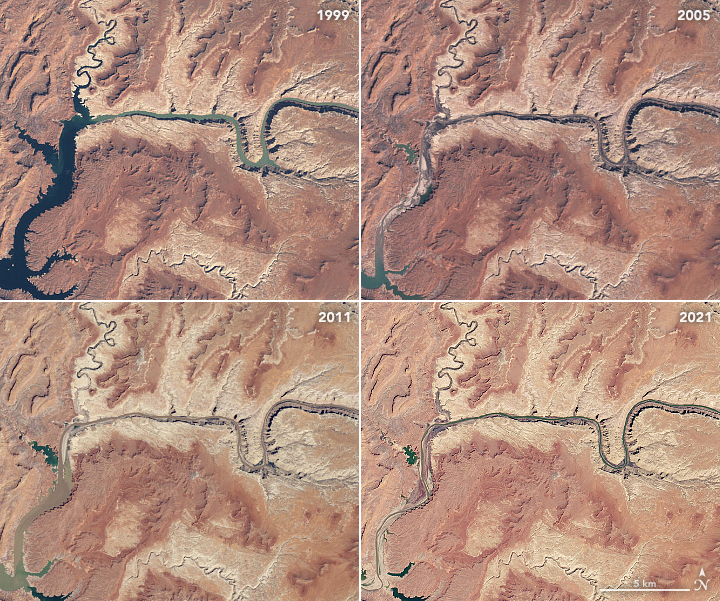
A Delta rocket launched the small Earth Resources Technology Satellite in July 1972 with a simple mission: to capture multi-spectral imagery of the planet and assess changes over time.
Data from the polar-orbiting satellite proved so useful that NASA and the US Geological Survey renamed the vehicle Landsat 1 in 1975, and the organizations have since launched a succession of increasingly sophisticated "Landsat" satellites to continue observations. As a result, we now have a nearly half-century long record of changes to the planet's surface—from farms and forests to glaciers and urban areas.
While the data from the Landsat missions has proved invaluable, it has also been somewhat depressing. The satellites have amassed an impartial record of tropical deforestation in the Amazon, verifying the claims of environmental protection organizations. They have also cataloged increasing water scarcity in the Western United States and chronicled ice losses across the vast majority of Earth's glaciers.
"Landsat has provided a critical reference for assessing long-term changes to Earth's land environment due to both natural and human forcing," scientists concluded in the journal Remote Sensing of Environment, in 2020.
Essentially, you can't manage what you can't measure. So if we're smarter about how we've changed the planet, perhaps humans can become smarter about how we change the planet in the future.

$1:
Natural color images from March 1999, April 2005, May 2011, and April 2021 by Landsat satellites chronicle the shrinking Lake Powell reservoir and Lower Colorado River.
A Delta rocket launched the small Earth Resources Technology Satellite in July 1972 with a simple mission: to capture multi-spectral imagery of the planet and assess changes over time.
Data from the polar-orbiting satellite proved so useful that NASA and the US Geological Survey renamed the vehicle Landsat 1 in 1975, and the organizations have since launched a succession of increasingly sophisticated "Landsat" satellites to continue observations. As a result, we now have a nearly half-century long record of changes to the planet's surface—from farms and forests to glaciers and urban areas.
While the data from the Landsat missions has proved invaluable, it has also been somewhat depressing. The satellites have amassed an impartial record of tropical deforestation in the Amazon, verifying the claims of environmental protection organizations. They have also cataloged increasing water scarcity in the Western United States and chronicled ice losses across the vast majority of Earth's glaciers.
"Landsat has provided a critical reference for assessing long-term changes to Earth's land environment due to both natural and human forcing," scientists concluded in the journal Remote Sensing of Environment, in 2020.
Essentially, you can't manage what you can't measure. So if we're smarter about how we've changed the planet, perhaps humans can become smarter about how we change the planet in the future.
https://arstechnica.com/science/2021/09 ... ervations/
Previous 1 ... 43 44 45 46 47 48 49 ... 72 Next